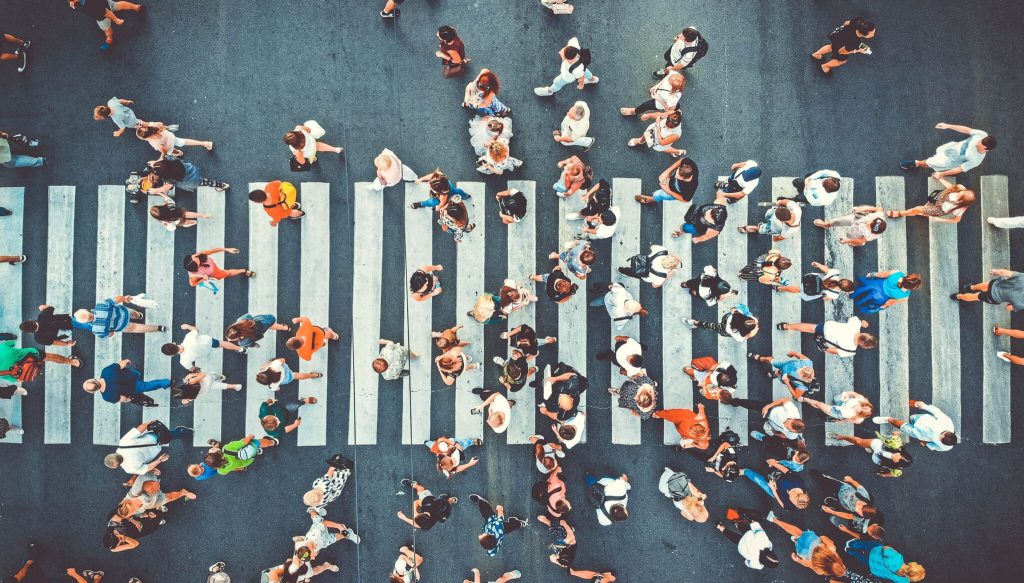

(© Dmytro – stock.adobe.com)
In a nutshell
- Crowds naturally form organized lanes when most people walk in two main directions, but become chaotic when walking directions vary beyond a critical threshold of 13-16 degrees.
- Walking speeds in disordered crowds are approximately 30% slower than in organized ones, showing how crowd order directly impacts pedestrian efficiency.
- Wider pedestrian crossings might actually reduce flow efficiency by allowing greater directional variation that disrupts the natural lane formation process.
CAMBRIDGE, Mass. — Walk through a busy train station during rush hour and you’ll notice something fascinating: people often form natural lanes, creating orderly streams moving in opposite directions. Yet step onto a crowded plaza with folks heading in multiple directions, and that organization vanishes into chaotic movement. This shift between order and chaos is no accident—it follows precise mathematical rules that scientists have now uncovered.
Recently published research in the Proceedings of the National Academy of Sciences reveals the mechanics behind how crowds transition between organized and disorganized states. A team from MIT, Poland’s Academy of Physical Education in Katowice, and the UK’s University of Bath found that this switch happens at a specific mathematical threshold.
The study examines what scientists call “motile active matter”—systems of independently moving entities. Unlike schools of fish or bacterial colonies that typically move as unified groups, humans in public spaces each have their own destination and path. This creates a perfect real-world laboratory for studying complex collective behaviors.
Researchers look at the “angular spread parameter” within crowds—essentially how varied people’s walking directions are. When pedestrians mostly walk in two opposite directions (think people crossing a street), they naturally form lanes. But introduce too many different walking angles into the mix, and order collapses into chaos.
Most surprisingly, this transition happens at a specific mathematical point. When the standard deviation of walking directions exceeds roughly 13-16 degrees, the crowd shifts from organized lanes to disorganized movement. This finding was consistent across mathematical theory, computer simulations, and experiments with real people.


To test their ideas, the team conducted experiments with over 70 participants in a gymnasium. They marked out a rectangular testing area with five “gates” at each end. Each participant received instructions about which gate to enter from and which to exit through. By controlling these entry and exit points, researchers could manipulate how varied the walking angles were.
The results confirmed their theory. When most participants walked straight across or at mild angles (below the critical threshold), they spontaneously formed orderly lanes. When instructed to walk at more varied angles exceeding the critical threshold, the crowd remained in disorder.
This has real-world implications. The experiments showed that walking speeds in disorganized crowds dropped by about 30% compared to organized ones—a significant efficiency loss that could affect pedestrian safety and crowd flow in public spaces.
“In this study, we set out to discover why some pedestrian crowds can spontaneously organize into neat flowing lanes, while others remain chaotic and disordered,” says Professor Tim Rogers from the University of Bath, in a statement. “Our new theory gives us a way to predict what kind of spaces encourage efficient use, and what are the conditions for order to break down.”
Consider the implications for urban design. A narrow pedestrian crossing naturally channels people into an orderly two-way flow. But what happens if planners widen that crossing? The research suggests that wider crossings might actually reduce efficiency by allowing too much directional variation, pushing the angular spread beyond the critical threshold and disrupting natural lane formation.
The mathematics behind this uses kinetic theory—typically applied to gas molecules. The researchers extended these equations to describe how pedestrians adjust their paths when avoiding collisions. Every time two people approach each other, they perform “collision avoidance maneuvers”—slowing down or stepping aside. These individual interactions ultimately determine whether organized patterns emerge at the crowd level.
Computer simulations revealed additional nuances. In perfectly bidirectional flows (like two groups crossing in exactly opposite directions), lanes formed and remained stable. However, in multidirectional crowds with varied but still sub-critical angular spread, lanes initially formed but then underwent “lane coarsening”—eventually clustering pedestrians together.
“This all makes intuitive sense,” says Karol Bacik from MIT. “The question is whether we can tackle it precisely and mathematically, and where the transition is. Now we have a way to quantify when to expect lanes—this spontaneous, organized, safe flow—versus disordered, less efficient, potentially more dangerous flow.”
This research goes beyond academic curiosity. It offers practical guidelines for designing safer, more efficient public spaces. Understanding the critical threshold for lane formation could help architects and urban planners create environments that naturally encourage orderly movement, potentially reducing congestion and improving evacuation safety.
The mundane act of crossing a pedestrian plaza reflects underlying mathematical order hiding in plain sight. Keep it in mind the next time you find yourself weaving your way through crowds. Look for those critical 13 degrees—the mathematical boundary where human movement transforms from organized efficiency into chaotic flow.
Paper Summary
Methodology
The research team used three complementary approaches. First, they developed mathematical models based on kinetic theory that describes how people move along preferred paths while avoiding collisions. This allowed them to analyze when crowds switch from mixed states to forming lanes. Second, they created computer simulations using “hard sphere” and “soft sphere” models, where virtual agents follow programmed movement rules while avoiding others. Finally, they conducted real experiments in a gymnasium with a marked 8m × 6m testing area. Over two sessions with 83 and 70 participants respectively, people received cards indicating which gates to use for entry and exit. This controlled setup allowed researchers to test five different scenarios with varying directional spreads. Overhead cameras recorded the movement patterns, which researchers later analyzed to measure lane formation and walking speeds across scenarios.
Results
The results clearly showed the transition between ordered and disordered movement as walking directions became more varied. In scenarios with low directional spread (most people walking in similar directions), lanes formed naturally. As directional spread increased, these organized patterns weakened until disappearing completely when the spread exceeded about 16 degrees—remarkably close to the theoretical prediction of 13 degrees. The impact on efficiency was substantial: walking speeds in disordered scenarios dropped by roughly 30% compared to well-organized flows. Researchers measured lane formation using a parameter that tracked how separated people moving in different directions were. This parameter decreased to zero as directional spread exceeded the critical threshold, confirming a clear phase transition. The width of emerging lanes was approximately 1.2 meters in the experiments, matching the prediction that lanes would be about twice as wide as a person.
Limitations
The researchers note several constraints to their work. Their theoretical analysis applies primarily to relatively sparse crowds where interactions happen mainly between pairs of pedestrians. In denser crowds, more complex interactions involving multiple people simultaneously might suppress lane formation through different mechanisms. For very sparse crowds, interactions become too infrequent to observe lane formation within reasonable timeframes—suggesting these patterns emerge most readily at medium densities. The simulations revealed complex non-linear effects like lane coarsening and clustering that weren’t fully explored experimentally due to time constraints. These effects might be influenced by simulation parameters and crowd density. Additionally, the experiments took place in controlled conditions with specific instructions. Real-world pedestrian flows involve additional factors like visual cues, architectural features, cultural behaviors, and varying pedestrian abilities that weren’t accounted for in this study.
Discussion and Takeaways
This research has direct applications for urban planning and crowd management. The finding that a specific critical threshold exists for lane formation challenges conventional design wisdom. For instance, increasing the width of a pedestrian crossing doesn’t necessarily increase its throughput capacity if wider crossings allow greater directional variation that disrupts lane formation. Beyond practical applications, the study advances theoretical understanding of active matter physics. It shows that human crowds, despite the complex psychology driving individual movement, follow mathematical principles similar to much simpler systems. The researchers note that their work creates a path toward more realistic yet manageable mathematical models of complex active systems. The order-disorder transition appears to be a fundamental property of multidirectional flows beyond just human movement, potentially applying to other systems with independent agents from animal groups to robot navigation.
Funding and Disclosures
This research received funding from the Engineering and Physical Sciences Research Council (grant EP/V048228/1). MIT’s SuperCloud and Lincoln Laboratory Supercomputing Center provided computational resources. The Academy of Physical Education in Katowice, Poland funded the experimental portion. All authors declared no competing interests, confirming the research was conducted without conflicts that might influence the findings. The authors used a Creative Commons Attribution (CC BY) license for their manuscript, making the findings freely available.
Publication Information
“Order–disorder transition in multidirectional crowds” appeared in the Proceedings of the National Academy of Sciences (PNAS) on March 24, 2025. The research team included Karol A. Bacik (MIT Department of Mathematics), Grzegorz Sobota and Bogdan S. Bacik (both from the Academy of Physical Education in Katowice, Poland), and Tim Rogers (University of Bath Department of Mathematical Sciences). Michael Cates from the University of Cambridge edited the paper, which was received October 8, 2024 and accepted February 17, 2025. It appears in Volume 122, Number 14 with the identifier e2420697122.








